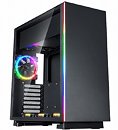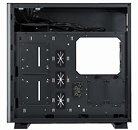Monday, October 15th 2018

Rosewill Prism S500 Is a Horizontally Partitioned Case with Bottom Compartment Up Top
Eons ago, when dinosaurs walked the Earth, ATX cases featured PSU bays above the motherboard tray, which found its rightful place below, so a PSU could breathe outside air from an intake vent, and direct it outside the case, instead of scooping up air from the motherboard's various hot components. The Rosewill Prism S500 is contemporary up to the point where it features a horizontally partitioned interior; but that the smaller half that packs the PSU bay and drive cages, is located above the larger half with the motherboard tray. A vent is located where most PSUs have their intake fans.
This layout means that the top panel is now completely devoid of any fan vents (which means no dust intake); and the bottom intake is freed up for a long vent that can hold up to three 120 mm fans in a row. There's also a side exhaust that can hold up to two 120 mm vents, and the 120 mm rear exhaust where you'd expect it to be. The motherboard tray has room for graphics cards up to 44 cm in length, and CPU coolers up to 16 cm in height. Lighting includes two RGB LED diffusers the accentuate the front panel's edges, and ring diffusers framing each of the six included 120 mm fans. All illuminated components feature addressable-RGB connections, so you could plug them directly to your motherboard's headers and control via software. Measuring 210 mm x 475 mm x 470 mm (WxHxD), the case weighs about 8 kg.
This layout means that the top panel is now completely devoid of any fan vents (which means no dust intake); and the bottom intake is freed up for a long vent that can hold up to three 120 mm fans in a row. There's also a side exhaust that can hold up to two 120 mm vents, and the 120 mm rear exhaust where you'd expect it to be. The motherboard tray has room for graphics cards up to 44 cm in length, and CPU coolers up to 16 cm in height. Lighting includes two RGB LED diffusers the accentuate the front panel's edges, and ring diffusers framing each of the six included 120 mm fans. All illuminated components feature addressable-RGB connections, so you could plug them directly to your motherboard's headers and control via software. Measuring 210 mm x 475 mm x 470 mm (WxHxD), the case weighs about 8 kg.




19 Comments on Rosewill Prism S500 Is a Horizontally Partitioned Case with Bottom Compartment Up Top
Because a small local vacuum cleaner under you case doesn’t help either.
Not a bad case. Just meh.
web.aub.edu.lb/pub/docs/atx_201.pdfIt *still* recommends this, even in the most recent revision, although it no longer makes the case as strongly:
www.intel.com/content/dam/www/public/us/en/documents/guides/power-supply-design-guide.pdf
There is no standard for an ATX motherboard tray. There is, however, a standard for ATX motherboards which includes positions for the mounting points. Cases either work with that standard or they don't work at all. Exactly HOW they choose to work with it is up to the manufacturer, however, which is why some motherboard manufacturers use a solid pin for the central mounting point rather than another screw - this allows users to get the board to sit in place so they can screw into a standoff without holding the motherboard in place.
Same for 5.25 and 3.5" devices. The drives have standard mounting screw locations. The cases however do not have standardised mounting hardware - there have been dozens (hundreds?) of different tool-less systems and drive caddy designs that all work with those mounting points in different ways. Most of the tool-less systems did happen to be plastic trash though, which is why cases that even HAVE 5.25" bays these days, don't have them very often.
If you want innovation in case design, then fine. But it's not because case manufacturers are bound by rules and regs directly. It's because the stuff inside is.
Also, for the sake of completeness here - the big issue with PSUs at the top of the case isn't heat. It's the distribution of weight. It's much easier to knock over a case with all that weight at the top than it is a case with the PSU at the bottom.
What an awful way to say it has a compartment up top. It's a top mounted PSU and shroud.
Yet somehow this case seems to marry the worst of both worlds: bottom mounted intakes and hot air to the PSU.
I was thinking ugh another btx style case...
Legacy
Standard ATX layout is
Io shield, 7 pci slots, correct amount of stand off holes. PSU up top, fan up front, fan in back.
The other atx standards expand on this.
Current atx mod spec is PSU in bottom with a fan in bottom and fan up top with 7-10 PCI slots.
My illusions!
Shattered!
Noooooooo!
Nothing wrong with that considering power supplies such as Corsair and XFX are made by Seasonic. There are certain models of rosewill power supplies that are really good.
It's the same as MSI, gigabyte ASRock Asus putting their name on reference cards from both Nvidia and AMD.
Don't Forget all the Clones of Chieftec, Antec, Chenming, Thermaltake Cases in early 2000s.
Besides, how fast are these computers taking turns? Probably double the speed limit which causes them to roll-over thanks to their high COG(center of gravity) :D
www.aerocool.com.tw/en/chssis/pgs-u/glo